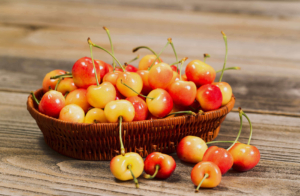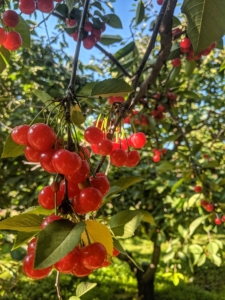Fruiting Cherries for Whidbey Island
**All our fruiting cherries are grown on dwarf rootstock to make them easier for bird netting and access to the fruit. Sour cherries (Prunus cerasus) are said to be self-fertile, but sweet cherries (Prunus avium) need a second sweet variety as a pollinator. Since sour and sweet are different species they do not pollinate each other.**
Sweet Cherries:
Angela
Has large, sweet, black fruit that resists cracking and disease. Angela ripens like Bing in mid-season. A self-pollinating tree but will perform better with another pollinator.
Bing
The most popular sweet cherry on the American market, Bing cherries produce large, dark smooth skinned fruit in mid-June to early July. The fruit is firm and extremely juicy and very sweet. Great for fresh eating, baking or preserves. One tree can be a heavy producer, with mature specimens producing 50-100 lbs of fruit in one year. The Bing Cherry will need a pollinator, such as Lapin or Sam, to produce fruit. A WSU Mt. Vernon recommended variety.
Lapin
An outstanding sweet dark cherry for Northwest gardens. The cherries are very large and crack resistant. The fruit is sweet and juicy, making it perfect for fresh eating or baking. The tree is disease resistant and very productive. An excellent substitute for Bing, which can crack in Western Washington. Self-fertile. Ripens in summer. A WSU Mt. Vernon recommended variety.
Rainier

An outstanding sweet cherry tree that produces delicious, large, fruit that are yellow with pink blush. Ripens before Bing, and larger than Royal Ann. This tree is a good pollinizer and is an easy to grow, low maintenance variety.
Sam
Considered a ‘black sweet’ cherry the fruit is dark red in color. Its flavor is similar to ‘Bing’ but a little tarter. Heavy producer and hardy to negative 20 degrees, it makes a great choice for home orchards. An excellent choice for the Pacific Northwest because of its resistance to cracking. Bing is a recommended pollinizer.
Vandalay
A large, sweet black cherry well suited to Northwest gardens. Very deep, wine-colored black cherries have firm red flesh and excellent flavor. Great eaten fresh. The cherries are crack-resistant and the tree is very productive. A disease resistant variety. Ripens in summer. Self-fertile. A WSU Mt. Vernon recommended variety.
Sweet Cherry 4-way Dwarf Combo
(4 of these 5 varieties grafted together) Bing, Rainier, Lapin, Glacier, Van, Royal Ann
Sour/Pie Cherries:
Montmorency
This variety has been cultivated in this country since the early 20th century. It is the most popular sour cherry in America. It produces a large, light red fruit for baking, drying and juicing.
Morello
This old variant fruit has deep crimson flesh that is tart and aromatic. The fruit’s wine-red juice is abundant and perfect for cooking and pie making. Ripens in August.
Surefire

Is so highly regarded it is considered the “first sour cherry.” This bright red fruit has high sugar content making it perfect for eating fresh or for making pies. Late blooming, late-flowering, crack resistant.
Need to know which trees pollinize which? Check out these Pollination Charts from Biringer Nursery.
